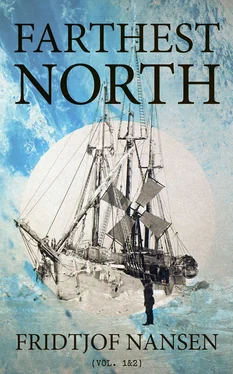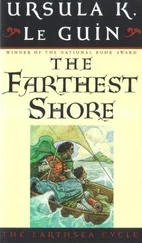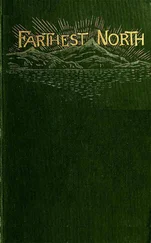Soon we were out of Yugor Strait. There was now so little fog that the low land round us was visible, and we could also see a little way out to sea, and, in the distance, all drift-ice. At 4 o’clock in the morning (August 4th) we glided past Sokolii, or Hawk Island, out into the dreaded Kara Sea.
Now our fate was to be decided. I had always said that if we could get safely across the Kara Sea and past Cape Cheliuskin, the worst would be over. Our prospects were not bad—an open passage to the east, along the land, as far as we could see from the masthead.
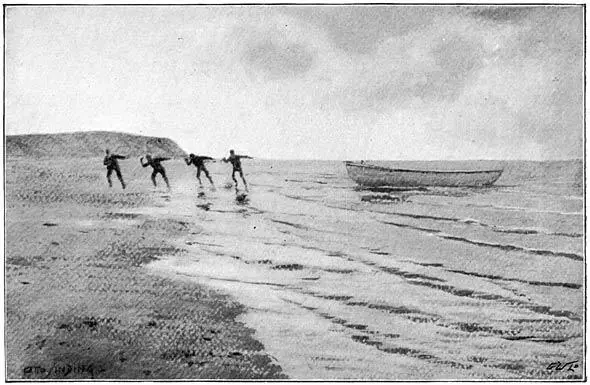
Landing on Yalmal
( By Otto Sinding, from a Photograph )
An hour and a half later we were at the edge of the ice. It was so close that there was no use in attempting to go on through it. To the northwest it seemed much looser, and there was a good deal of blue in the atmosphere at the horizon there. 1We kept southeast along the land through broken ice, but in the course of the day went further out to sea, the blueness of the atmosphere to the east and northeast promising more open water in that direction. However, about 3 P.M. the ice became so close that I thought it best to get back into the open channel along the land. It was certainly possible that we might have forced our way through the ice in the sea here, but also possible that we might have stuck fast, and it was too early to run this risk.
Next morning (August 5th), being then off the coast near to the mouth of the River Kara, we steered across towards Yalmal. We soon had that low land in sight, but in the afternoon we got into fog and close ice. Next day it was no better, and we made fast to a great ice-block which was lying stranded off the Yalmal coast.
In the evening some of us went on shore. The water was so shallow that our boat stuck fast a good way from the beach, and we had to wade. It was a perfectly flat, smooth sand-beach, covered by the sea at full tide, and beyond that a steep sand-bank, 30 to 40 feet, in some places probably 60 feet, high.
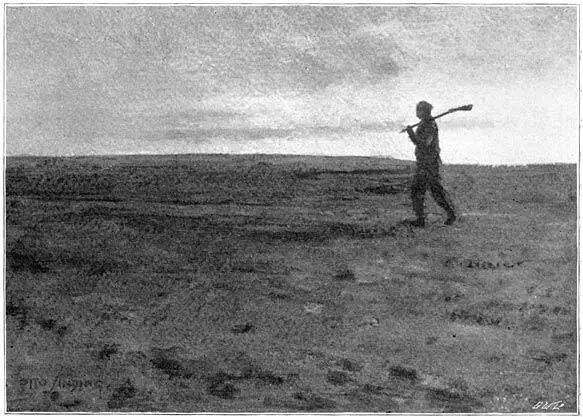
The plain of Yalmal
( By Otto Sinding, from a Photograph )
We wandered about a little. Flat, bare country on every hand. Any driftwood we saw was buried in the sand and soaking wet. Not a bird to be seen except one or two snipe. We came to a lake, and out of the fog in front of me I heard the cry of a loon, but saw no living creature. Our view was blocked by a wall of fog whichever way we turned. There were plenty of reindeer tracks, but of course they were only those of the Samoyedes’ tame reindeer. This is the land of the Samoyedes—and oh but it is desolate and mournful! The only one of us that bagged anything was the botanist. Beautiful flowers smiled to us here and there among the sand-mounds—the one message from a brighter world in this land of fogs. We went far in over the flats, but came only to sheets of water, with low spits running out into them, and ridges between. We often heard the cry of loons on the water, but could never catch sight of one. All these lakelets were of a remarkable, exactly circular conformation, with steep banks all round, just as if each had dug out a hole for itself in the sandy plain.
With the oars of our boat and a large tarpaulin we had made a sort of tent. We were lucky enough to find a little dry wood, and soon the tent was filled with the fragrant odor of hot coffee. When we had eaten and drunk and our pipes were lit, Johansen, in spite of fatigue and a full meal, surprised us by turning one somersault after another on the heavy, damp sand in front of the tent in his long military cloak and sea-boots half full of water.
By 6.30 next morning we were on board again. The fog had cleared, but the ice, which lay drifting backward and forward according to the set of the tide, looked as close as ever towards the north. During the morning we had a visit from a boat with two stalwart Samoyedes, who were well received and treated to food and tobacco. They gave us to understand that they were living in a tent some distance inland and farther north. Presently they went off again, enriched with gifts. These were the last human beings we met.
Next day the ice was still close, and, as there was nothing else to be done, some of us went ashore again in the afternoon, partly to see more of this little-known coast, and partly, if possible, to find the Samoyedes’ camp, and get hold of some skins and reindeer flesh. It is a strange, flat country. Nothing but sand, sand everywhere. Still flatter, still more desolate than the country about Yugor Strait, with a still wider horizon. Over the plain lay a green carpet of grass and moss, here and there spoiled by the wind having torn it up and swept sand over it. But trudge as we might, and search as we might, we found no Samoyede camp. We saw three men in the far distance, but they went off as fast as they could the moment they caught sight of us. There was little game—just a few ptarmigan, golden plovers, and long-tailed ducks. Our chief gain was another collection of plants, and a few geological and geographical notes. Our observations showed that the land at this place was charted not less than half a degree or 36 to 38 minutes too far west.
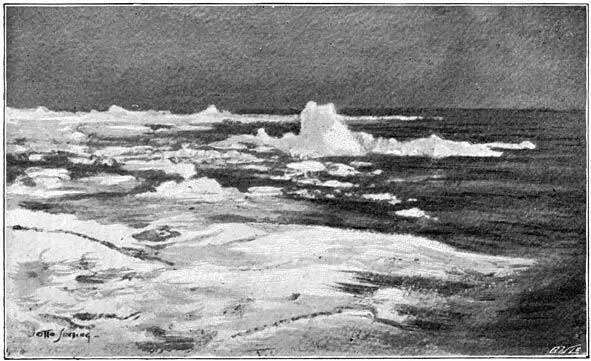
In the Kara Sea
It was not till next forenoon (August 9th) that we went on board again. The ice to the north now seemed to be rather looser, and at 8 P.M. we at last began once more to make our way north. We found ice that was easy to get through, and held on our course until, three days later, we got into open water. On Sunday, August 18th, we stood out into the open Kara Sea, past the north point of Yalmal and Bieloi-Ostrov (White Island). There was no ice to be seen in any direction. During the days that followed we had constant strong east winds, often increasing to half a gale. We kept on tacking to make our way eastward, but the broad and keelless Fram can hardly be called a good “beater”; we made too much leeway, and our progress was correspondingly slow. In the journal there is a constantly recurring entry of “Head-wind,” “Head-wind.” The monotony was extreme; but as they may be of interest as relating to the navigation of this sea, I shall give the most important items of the journal, especially those regarding the state of the ice.
On Monday, August 14th, we beat with only sail against a strong wind. Single pieces of ice were seen during the middle watch, but after that there was none within sight.
Tuesday, August 15th. The wind slackened in the middle watch; we took in sail and got up steam. At 5 in the morning we steamed away east over a sea perfectly clear of ice; but after mid-day the wind began to freshen again from E.N.E., and we had to beat with steam and sail. Single floes of ice were seen during the evening and night.
Wednesday, August 16th. As the Kara Sea seemed so extraordinarily free from ice, and as a heavy sea was running from the northeast, we decided to hold north as far as we could, even if it should be to the Einsamkeit (Lonely) Island. But about half-past three in the afternoon we had a strip of close ice ahead, so that we had to turn. Stiff breeze and sea. Kept on beating east along the edge of the ice. Almost lost the petroleum launch in the evening. The waves were constantly breaking into it and filling it, the gunwale was burst in at two places, and the heavy davits it hung on were twisted as if they had been copper wires. Only just in the nick of time, with the waves washing over us, some of us managed to get it lashed to the side of the ship. There seemed to be some fatality about this boat.
Читать дальше
